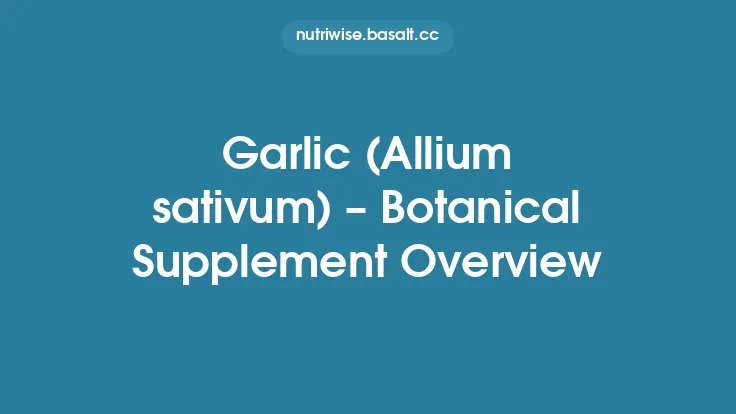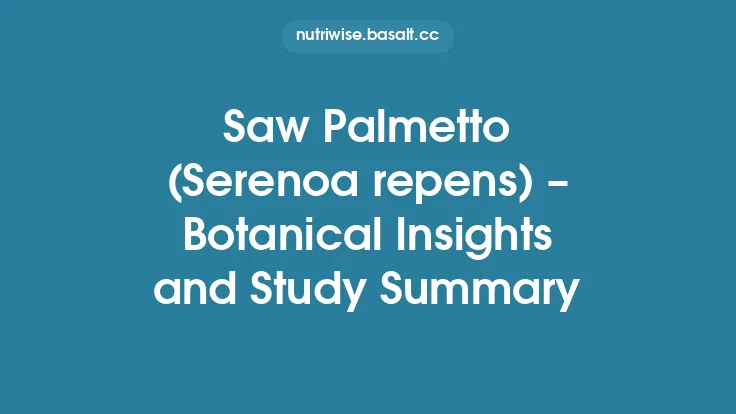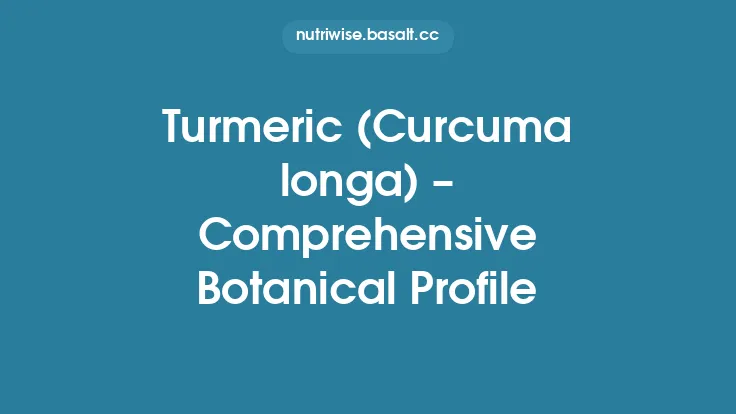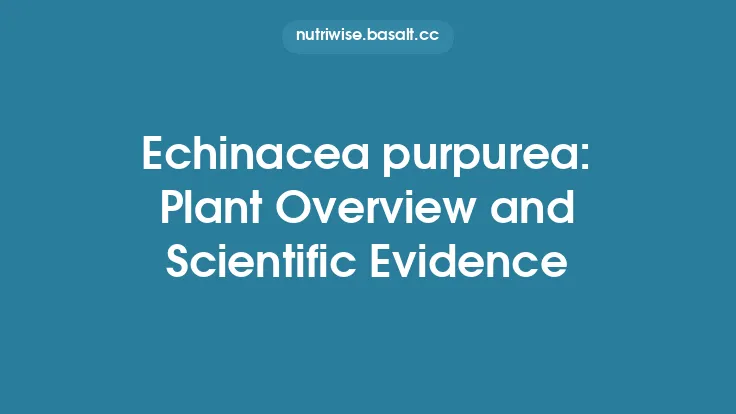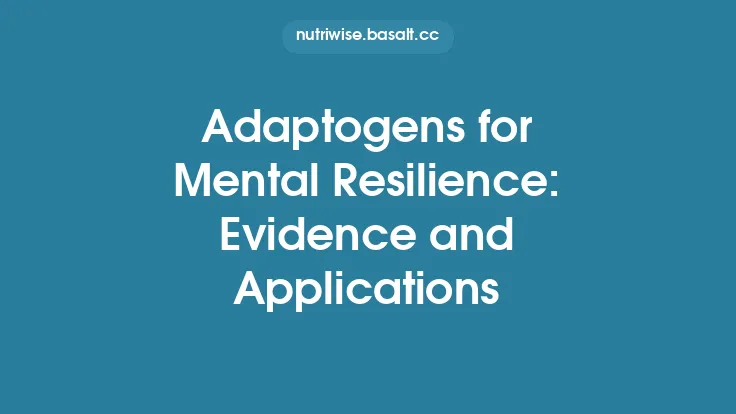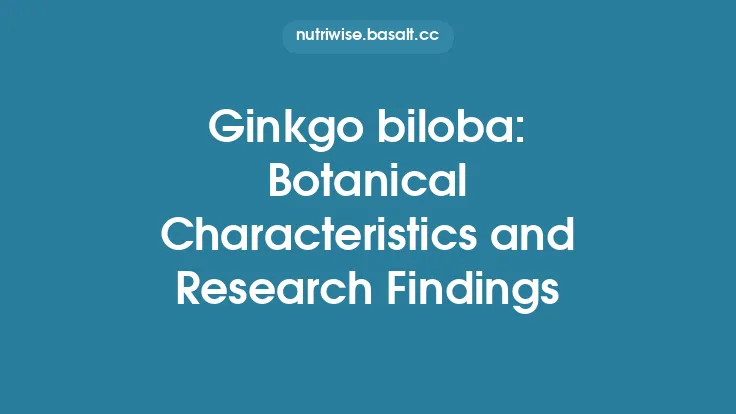Hawthorn (Crataegus spp.) has been cultivated and harvested for centuries across temperate regions of the Northern Hemisphere, where its dense clusters of white‑to‑pink blossoms and bright red berries have long been valued both ornamentally and medicinally. In contemporary herbal practice, hawthorn is most frequently employed as a cardiovascular tonic, but its pharmacological profile extends to antioxidant, anti‑inflammatory, and neuroprotective activities. This overview synthesizes the botanical characteristics, phytochemical constituents, traditional applications, and the current state of scientific evidence, providing a comprehensive reference for clinicians, researchers, and supplement formulators.
Taxonomy and Species Diversity
- Family: Rosaceae
- Genus: *Crataegus*
- Commonly Used Species: *C. monogyna (European hawthorn), C. laevigata (Midland hawthorn), C. pinnatifida (Chinese hawthorn), C. oxyacantha* (American hawthorn) and several hybrids.
- Chromosome Numbers: Most species are diploid (2n = 34), though polyploidy (tetraploid, hexaploid) occurs in certain cultivars, influencing fruit size and phytochemical yield.
- Geographic Distribution: Native to Europe, North America, and East Asia; naturalized in many temperate zones. The species exhibit considerable morphological variation, which can affect the concentration of bioactive compounds.
Botanical Description
- Growth Habit: Deciduous shrubs or small trees, typically 3–10 m tall. Branches are often armed with sharp, rigid thorns (hence the name “hawthorn”).
- Leaves: Alternate, simple, serrated margins; size 3–10 cm long, turning bright orange‑red in autumn.
- Flowers: Small (5–10 mm diameter), five‑petaled, white to pink, arranged in corymbs. Each flower contains numerous stamens, a characteristic feature of the Rosaceae family.
- Fruit (Haw): A pomaceous berry, 5–15 mm in diameter, turning from green to bright red (or orange in some Asian species) upon ripening. The fruit contains a single hard endocarp (stone) encasing several seeds.
- Phenology: Flowering occurs in late spring (April–June in the Northern Hemisphere), with fruit maturation in late summer to early autumn. The timing of harvest is critical for optimal phytochemical content; berries are typically collected when fully colored but still firm.
Phytochemistry
Hawthorn’s therapeutic potential is attributed to a complex matrix of flavonoids, oligomeric proanthocyanidins (OPCs), phenolic acids, and triterpenic acids. The distribution of these constituents varies among plant parts (leaves, flowers, fruit) and among species.
| Compound Class | Representative Molecules | Predominant Plant Part | Approximate Content* |
|---|---|---|---|
| Flavonoids | Vitexin, rutin, quercetin, hyperoside, isoquercitrin | Leaves, flowers | 1–3 % dry weight |
| Proanthocyanidins | B-type dimers to hexamers (epicatechin, catechin) | Fruit, leaves | 2–5 % dry weight |
| Phenolic Acids | Chlorogenic acid, caffeic acid, ferulic acid | All parts | 0.5–1 % dry weight |
| Triterpenic Acids | Oleanolic acid, ursolic acid, maslinic acid | Leaves, bark | 0.2–0.8 % dry weight |
| Vitamins & Minerals | Vitamin C, potassium, magnesium | Fruit | Variable |
\*Values are based on typical extracts prepared from dried plant material; they can differ markedly with harvest time, extraction solvent, and cultivar.
Flavonoid Glycosides
Flavonoid glycosides such as vitexin (apigenin‑8‑C‑glucoside) and hyperoside (quercetin‑3‑O‑galactoside) are abundant in hawthorn leaves and flowers. These molecules exhibit strong free‑radical scavenging activity and modulate endothelial nitric oxide synthase (eNOS) pathways, contributing to vasodilatory effects.
Proanthocyanidins (OPCs)
The oligomeric proanthocyanidins, especially those of degree of polymerization (DP) 2–4, are potent antioxidants and have been shown to inhibit platelet aggregation. Their bioavailability is limited; however, microbial metabolism in the colon yields phenolic metabolites that retain biological activity.
Triterpenic Acids
Oleanolic and ursolic acids are pentacyclic triterpenes with documented anti‑inflammatory and cardioprotective actions. They interact with nuclear factor‑κB (NF‑κB) signaling and may attenuate myocardial remodeling.
Traditional and Ethnobotanical Uses
- Cardiovascular Support: In European folk medicine, hawthorn decoctions were prescribed for “weak heart” conditions, palpitations, and mild hypertension.
- Digestive Aid: The fruit was used as a mild laxative and to alleviate dyspepsia.
- Respiratory Applications: In Chinese traditional medicine, *C. pinnatifida* (Shan Zha) is employed to improve appetite and to treat coughs associated with phlegm.
- Topical Uses: Crushed leaves and bark have been applied to wounds for their astringent properties.
These historical applications have guided modern research, particularly the focus on cardiovascular endpoints.
Clinical Evidence Synopsis
1. Heart Failure (Mild to Moderate, NYHA Class I–II)
- Study Design: Randomized, double‑blind, placebo‑controlled trials (e.g., the “Hawthorn Extract in Chronic Heart Failure” study, n = 210).
- Intervention: Standardized leaf extract containing 2.2 % flavonoids and 18–20 % OPCs, 250 mg twice daily for 12 weeks.
- Outcomes: Significant improvements in left ventricular ejection fraction (LVEF ↑ + 5 % vs. placebo), reduced exercise intolerance (6‑minute walk test ↑ + 45 m), and lower NYHA class scores.
- Safety: No serious adverse events; mild gastrointestinal discomfort reported in <5 % of participants.
2. Hypertension
- Meta‑analysis (2021, 8 RCTs, n = 1,024): Hawthorn extract (250–500 mg/day) produced a modest systolic blood pressure reduction of 4–6 mm Hg and diastolic reduction of 2–4 mm Hg compared with placebo. Effects were more pronounced in subjects with baseline SBP > 140 mm Hg.
3. Angina Pectoris
- Controlled Crossover Study (n = 45): 300 mg/day of standardized leaf extract for 4 weeks reduced frequency of anginal episodes by 30 % and increased time to onset of chest pain during treadmill testing.
4. Antioxidant Biomarkers
- Intervention Trial (n = 60, healthy volunteers): 8‑week supplementation with 200 mg hawthorn extract increased plasma total antioxidant capacity (TAC) by 15 % and decreased malondialdehyde (MDA) levels, indicating reduced lipid peroxidation.
5. Cognitive Function (Preliminary)
- Small pilot studies suggest modest benefits on attention and working memory in older adults, possibly mediated by improved cerebral perfusion; however, data remain insufficient for definitive conclusions.
Overall Assessment: The preponderance of evidence supports hawthorn’s role as an adjunctive therapy for mild to moderate chronic heart failure and as a modest antihypertensive agent. The quality of trials varies, with many studies limited by short duration, small sample sizes, and heterogeneity in extract standardization. Larger, multicenter trials with long‑term follow‑up are needed to confirm mortality and morbidity outcomes.
Safety, Contraindications, and Drug Interactions
- General Tolerability: Hawthorn is well tolerated at typical doses (150–900 mg/day of standardized extract). Reported adverse events are mild (nausea, headache, dizziness).
- Contraindications: Caution in patients on potent anti‑arrhythmic drugs (e.g., class I agents) due to potential additive effects on cardiac conduction.
- Pharmacokinetic Interactions: Hawthorn flavonoids can inhibit CYP2D6 and CYP3A4 in vitro; clinically relevant interactions have been observed with digoxin, where hawthorn may increase serum digoxin concentrations by up to 30 %. Monitoring of digoxin levels is advised when co‑administered.
- Pregnancy & Lactation: Insufficient data; traditional use suggests avoidance during the first trimester.
- Allergy: Individuals with known sensitivity to Rosaceae family members (e.g., apples, pears) may experience cross‑reactivity.
Dosage Forms, Standardization, and Quality Considerations
| Form | Typical Standardization | Recommended Daily Dose* |
|---|---|---|
| Standardized Leaf Extract (capsules/tablets) | 2.2 % flavonoids, 18–20 % OPCs (by HPLC) | 250–500 mg (divided) |
| Standardized Flower Extract | 1.5 % flavonoids, 10 % OPCs | 200–400 mg |
| Fruit (Dried) Powder | Not routinely standardized; high vitamin C | 1–2 g |
| Liquid Tincture (alcoholic) | 1 : 5 (w/v) with 0.5 % flavonoids | 20–30 drops (≈100 mg) |
| Tea (infusion of dried leaves/flowers) | No standardization; flavonoid content ~0.5 % | 2–3 g herb per cup |
\*Doses are based on clinical trial regimens and may be adjusted according to individual health status and practitioner guidance.
Quality Assurance:
- Authentication: DNA barcoding (e.g., rbcL, matK) is increasingly employed to confirm species identity, especially in mixed‑species raw material batches.
- Contaminant Testing: Heavy metal (Pb, Cd, Hg, As) and pesticide residues must meet USP or EFSA limits.
- Stability: Flavonoid glycosides are relatively stable under dry, cool conditions; however, exposure to light and high humidity can degrade OPCs. Proper packaging (amber glass or high‑barrier foil) is recommended.
Cultivation, Harvest, and Sustainability
- Agronomic Practices: Hawthorn tolerates a wide range of soils (pH 5.5–7.5) and is moderately drought‑resistant. Pruning to promote air circulation reduces fungal disease pressure (e.g., *Venturia* spp.).
- Harvest Timing: Leaves are best collected in early summer when flavonoid content peaks; fruit is harvested at full coloration but before over‑ripening to preserve OPCs.
- Post‑Harvest Processing: Rapid drying (≤45 °C) preserves phenolic integrity. Freeze‑drying of fruit retains vitamin C and anthocyanins for nutraceutical applications.
- Environmental Impact: Hawthorn is a native species in many regions, supporting pollinator habitats. Sustainable wild‑harvesting protocols (e.g., rotating collection sites, limiting removal to ≤30 % of canopy) help maintain ecological balance.
Research Gaps and Future Directions
- Long‑Term Cardiovascular Outcomes: Large-scale, double‑blind trials evaluating mortality, hospitalization, and quality‑of‑life endpoints in heart failure patients.
- Mechanistic Studies: Elucidation of molecular pathways linking flavonoid‑mediated eNOS activation to myocardial remodeling; investigation of gut microbiota‑derived metabolites of OPCs.
- Standardization of Fruit Extracts: While leaf extracts are well characterized, fruit‑based preparations lack consistent phytochemical benchmarks; development of validated markers (e.g., specific anthocyanins) is needed.
- Interaction with Modern Cardiovascular Drugs: Systematic pharmacokinetic studies with beta‑blockers, ACE inhibitors, and novel anticoagulants.
- Neurovascular Applications: Exploration of hawthorn’s potential to improve cerebral blood flow and protect against ischemic injury, leveraging its antioxidant and vasodilatory properties.
Concluding Perspective
Hawthorn (*Crataegus* spp.) stands out among botanical cardiovascular agents for its robust historical use, well‑documented phytochemical profile, and a growing body of clinical data supporting modest but meaningful benefits in heart failure and hypertension. The herb’s safety record, coupled with its multifaceted mechanisms—antioxidant, anti‑inflammatory, positive inotropic, and vasodilatory—makes it a valuable adjunct in integrative cardiology. Nonetheless, practitioners should remain vigilant regarding potential drug interactions, especially with digoxin and CYP‑modulating medications. Continued investment in high‑quality, standardized extracts and rigorously designed clinical trials will be essential to fully delineate hawthorn’s therapeutic scope and to integrate it responsibly into modern supplement regimens.
